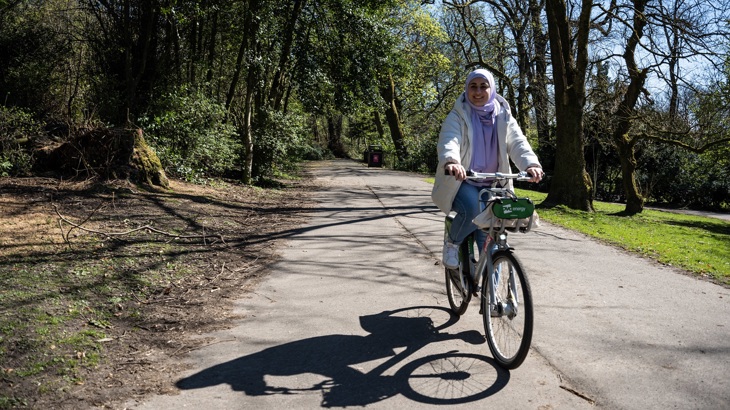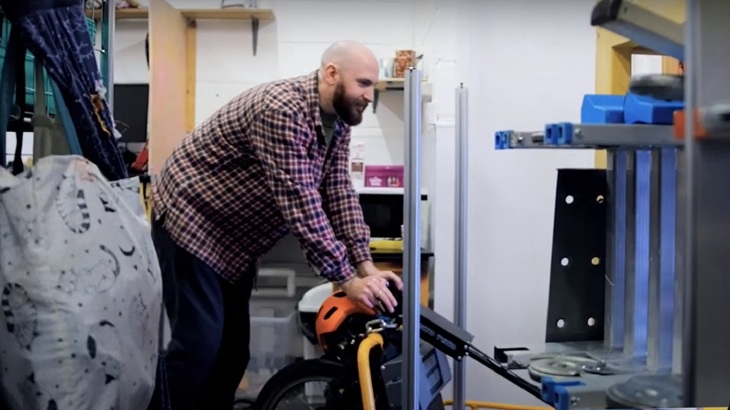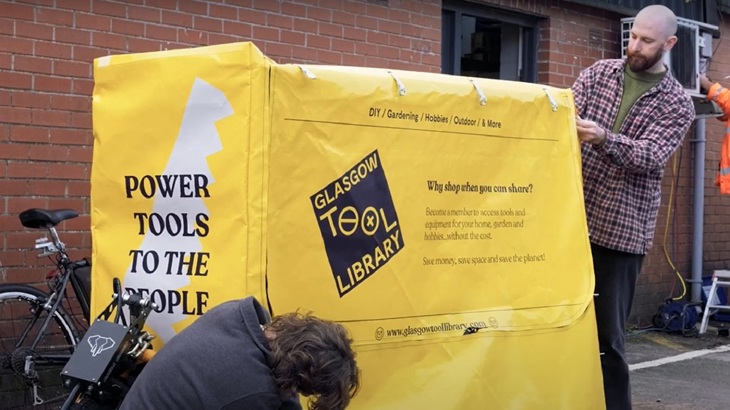As the Walking and Cycling Index reveals the latest assessment of walking, wheeling and cycling in Glasgow we meet the team behind an organisation that is cutting emissions as well as helping ease the pressure of the cost of living crisis in Scotland’s largest city.
What is the Walking and Cycling Index, and what does it mean for Glasgow?
The Walking and Cycling Index is the biggest assessment of walking, wheeling and cycling in urban areas in the UK and Ireland. In Scotland, the Index is delivered by Sustrans in collaboration with eight cities. Each city reports on the progress made towards making walking, wheeling and cycling more attractive, everyday ways to travel.

The third Walking and Cycling Index for Glasgow was published in March 2024. Credit: Brian Sweeney/Sustrans
The Index reports every two years. This is the third report from Glasgow produced in partnership with Glasgow City Council. Data in the report comes from 2023 and includes local walking, wheeling and cycling data, modelling and an independent survey of 1,333 residents aged 16 or above in the city.
The Index found that, in Glasgow, 56% of residents walk or wheel five days a week, and that 17% of residents cycle at least once a week.
Overall in the city, 21% of residents want to drive less, yet 30% often use a car because no other transport options are available. And in terms of funding, 60% of residents would like to see more government spending in the area on walking and wheeling.
To mark publication of the report, we spoke to the Glasgow Tool Library team about their experiences operating an e-bike and trailer in the city.

Chris Strachan is one of the co-founders of Glasgow Tool Library. Credit: Brian Sweeney/Sustrans
E-cargo bike trailer versus van
My name's Chris Strachan, one of the co-founders of Glasgow Tool Library. The aim behind the Library is to help people save money and reduce their consumption by providing access to useful tools and equipment that people can use for their homes, gardens and hobbies.
We started using an e-cargo bike and trailer because we were looking for ways to expand the library across Glasgow. We were interested in how we could expand to different locations and what business models could help achieve that. Initially we looked into buying an electric van to run our drop-off and collection service at different collection points, but it was expensive and didn't seem practical for us as a small organisation. So we looked into different e-cargo possibilities. We needed something that would have enough space for tools - they're quite large objects with different sizes and quite hard to pack in.
It was important for us to choose a sustainable form of transport because the whole aim of Glasgow Tool Library is to help transition us from a wasteful form of consumerism that's really bad for our planet towards something where we can access the resources we need in a sustainable way, cutting down waste and embedded carbon in the products we use. We in the city centre don't really need vans to make small journeys. So we thought it would be a good opportunity to try and promote that within our business model.
At first Bike for Good lent us an e-cargo bike. That was really great to test it initially, to help us understand the practicality of using it, what was feasible and wasn't. After that pilot, we got funding from a few different sources including the Hugh Fraser Foundation, The Robertson Trust and Scotland Loves Local for the first year to run the service using a Carla Cargo trailer.
One of the benefits of using the trailer in the city is that where there are cycle paths, it can be a lot quicker to get around the city centre than a van that gets stuck in traffic. It is also something that is easy for different people to use, including our volunteers. You don't need a licence, just a bit of training to use it.

Harry (l) and Chris from Glasgow Tool Library are shown with the trailer. Credit: Brian Sweeney/Sustrans
Saving money and reducing emissions across Glasgow
The service we've been using the e-bike and trailer for is our Hub and Spoke delivery service. We've been working with community centres, in the East End and in the South West of Glasgow, working with Barrowfield Community Hub and Kinning Park Complex. People can reserve tools online and then we pack them up in our trailer from our hub in Maryhill, and bring them down to those community centres, for people to come and collect and return them.
The bike service has saved us over 150 journeys, going back and forth between those community centres. We've been going once a week for a couple of hours, and try to tie in with existing activities they've got going on. At Kinning Park Complex, for example, we have been going every Thursday evening, when they have their community meal. Overall this service has been used by 270 people, who loaned over 1,000 tools. This has saved people over £50,000 and just under seven tonnes of carbon from borrowing instead of buying new things.

Harry is shown using the e-bike cargo trailer in Glasgow. Credit: Brian Sweeney/Sustrans
Using an e-cargo bike in Glasgow
Harry is the cycle courier at Glasgow Tool Library, running the drop-off and collection service for the organisation.
One of the benefits of using the bike over using a van is that, by using the segregated cycle paths, I don't have to worry so much about traffic. I don't need to allow extra time for traffic if I'm going during rush hour. It's also a point of interest for people using the service. It's interesting for people to see a bike trailer and learn about the fact that we're using alternative modes of transport to deliver our service.
The segregated cycle paths in the city have made my cycling journeys easier. I can't really imagine doing this kind of cycling without them. Even getting stuck in traffic would be difficult because you can't really weave in and out of cars because of the massive trailer behind you. Also, drivers in Glasgow are not that used to seeing large trailers on the backs of bikes so they're not kind or accommodating to the fact that I'm out there with this huge thing on the back of my bike and being a bit slower than a normal cyclist and taking up a lot of room.
So being able to get away from cars using cycle lanes is good. Also, the road surfaces tend to be a lot better on the segregated cycle paths. The roads in Glasgow are not in a good condition and avoiding potholes is quite important when using the bike trailer, especially if you are carrying a lot of heavy tools on the back.
I think it would be great to see more people feeling able to use cargo bikes and bike trailers for work. And I think this would really help improve the attitude of drivers towards cyclists in general, because you're not just out on your jollies, you're using it to deliver a service and contributing to Glasgow.
Improving the experience to inspire others onto e-cargo bikes
Some improvements that I'd like to see in Glasgow to improve cycling with a bike trailer would include introducing more segregated cycle paths, and more bike-specific traffic lights.
As well as this, attitudes towards cyclists changing through more regulations that are cycle positive, and better education around the needs and the benefits of cycling would be really positive and that could probably encourage more people to use bike trailers and cycle to work, and use cycling within work like we are. And that would only help to increase education and positive attitudes towards cycling.
We're hoping that by using a bike trailer to deliver our service, we could encourage other individuals and organisations to do the same and cycle within their service or their workplace.
Hopefully more organisations like us start incorporating cycling and bike trailers into their services which could encourage other individuals and organisations to use bikes. And increased visibility will only lead to better attitudes towards cyclists in the city.





